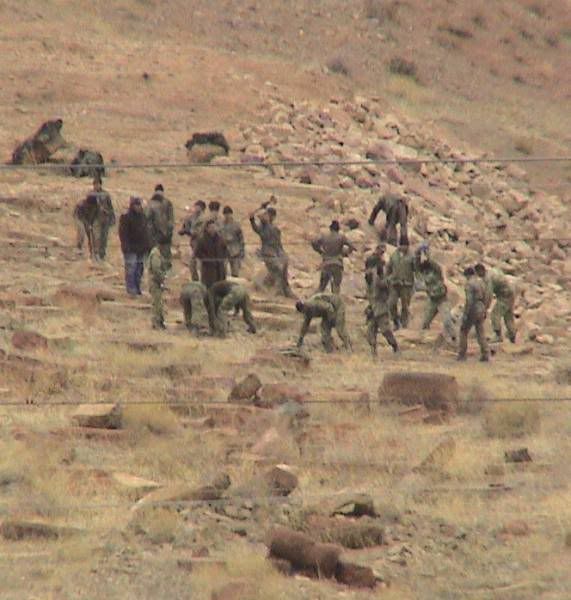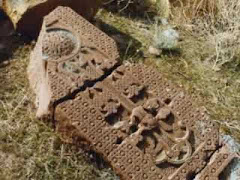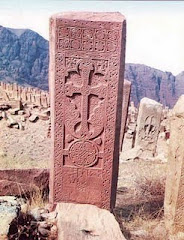Sunday, June 20, 2010
Monday, June 14, 2010
 Խաչքար՝ նահատակված խաչքարերին
Խաչքար՝ նահատակված խաչքարերինՀՈՎՀԱՆՆԵՍ ՍԱՐԴԱՐՅԱՆ, 2010-06-11
Վանաձորցի քանդակագործ Բոգդան Հովհաննիսյանը յուրօրինակ նախաձեռնությամբ է հանդես եկել. նա նույնությամբ վերականգնել է Ջուղայում ադրբեջանցիների կողմից ոչնչացրած 10 հազար խաչքարերից մեկը:
«Ջուղայի խաչքարագործության արվեստը լրիվ տարբերվում է մեր խաչքարագործությունից: Առաջին հայացքից թվում է՝ նույնն է, բայց հենց գործիքը վերցնում ու փորձում են աշխատել, անմիջապես ի հայտ են գալիս տարբերությունները»,- Ջուղայի հայկական գերեզմանատան խաչքարերից Ծատուրին նվիրվածի վերականգնման առիթով ասում է Բ. Հովհաննիսյանը:
Խաչքարը կերտվել է շուրջ 10 ամսվա ընթացքում: «Ավելի շուտ կավարտեի, բայց նախ ամեն նախշը կոթողի վրա էի նկարում, հետո փոխադրում քարին,- պատմում է քանդակագործն ու հավելում զարմանալի մի իրողություն,- գուցե խորհրդանշական է, բայց մինչեւ զինվորականի հագուստ չհագա, ոչինչ չստացվեց: Առաջին մի ամսվա ընթացքում այդ համազգեստով էի աշխատում»:
Խաչքարի կերտման գործում Բոգդան Հովհաննիսյանին օժանդակել է «Ջուղաքար» գրքի հեղինակ Արգամ Այվազյանը՝ տրամադրելով ինչպես այդ գրքի օրինակը, այնպես էլ այն խաչքարի բնօրինակի լուսանկարը, որը վերականգնել է քանդակագործը: Խաչքարը փորագրման հինգ մակարդակ-հարթություն ունի, ինչպես նաեւ զգալիորեն բարդ զարդանախշեր: Քանդակագործը հենց այս խաչքարը վերակերտելն էլ նախախնամություն է համարում: Աստվածատուրը եւ Բոգդանը նույն իմաստն ունեն՝ Աստծո կողմից: «Մեկ խաչքարը քիչ է, պետք է էլի կերտել ու Ջուղայի զոհված խաչքարերին նվիրված հուշարձանախումբ ստեղծել, որ Գուգարաց թեմի առաջնորդ գերաշնորհ տեր Սեպուհ եպիսկոպոս Չուլջյանի համաձայնությամբ կտեղադրվի Վանաձորի Սուրբ Գրիգոր Նարեկացի եկեղեցու կանաչ պուրակում: Մնում է հովանավոր գտնել, ով պատրաստ լինի օժանդակել այս կարեւոր նախաձեռնությանը»,- ասում է Բոգդան Հովհաննիսյանը ու հույսով սպասում մեկենասի հայտնվելուն: Նա պատրաստ է անգամ նվիրել հայոց խաչքարագործության մեջ առաջին կրկնօրինակ նմուշը, որի Ջուղայում եղած տարբերակը 16-րդ դարի (1602 թ.) կոթող է եղել:
Friday, June 11, 2010
Monday, June 7, 2010
2008-11-12 20:50:00
Кладбище Джульфы
Азербайджанские власти на протяжении всего советского периода старались уничтожить этот некрополь, поскольку для них он был всего лишь свидетельством о том, что именно армяне были хозяевами этой территории на протяжении веков, вопреки тому, что говорилось в азербайджанских советских мифах о собственной “древности”… Это кладбище, вполне достойное названия чуда, было даже не внесено в реестр архитектурных памятников Азербайджана… После распада СССР, во время карабахского конфликта, продолжалось разорение кладбища, и, наконец, оно было окончательно уничтожено….
The Azeri authorities throughout all Soviet period tried to destroy this necropolis as for them it was only a testament that Armenians were owners of this territory throughout centuries in spite of Azerbaijan’s Soviet myths about own “antiquity”… This cemetery, quite worthy to be called a wonder, was not even placed on the register of architectural monuments of Azerbaijan… After USSR’s collapse, during the Karabakh conflict, the cemetery’s demolition continued, and, at last, definitively destroyed….
Blogian on 16 Dec 2008
Three years after a cemetery dating back to the 9th Century was deliberately destroyed in the Azerbaijani exclave of Nakhichevan, bloggers recall an ancient culture annihilated and condemn the world for closing its eyes to what many consider to be an official attempt to rewrite history.
NoThingfjord, a Turkish blog, writes:
Today is the commemoration of the 3rd anniversary of Djulfa’s destruction. …This [is] not only a crime against Armenian culture, but against our collective cultural heritage as humankind. Don’t let it go unnoticed.
Between 10-16 December 2005 over a hundred uniformed men were videotaped destroying the Djulfa cemetery using sledgehammers, cranes, and trucks. The video was taken from across the border in Iran.
Please visit the following site: http://www.ancestralstones.com/cultural_genocide_en.pdf
“There are thousands of khatchkars (cross-stones) here. Each khatchkar could very easily become a rare exhibit in any of the most famous European museums… If all of Europe’s millionaires were to enter the old Djulfa forest of khatchkars and come out bankrupt, the forest would not be endangered in any way.” – A European scholar on the Djulfa cemetery before the destruction
“A medieval cemetery regarded as one of the wonders of the Caucasus has been erased from the Earth in an act of cultural vandalism likened to the Taleban blowing up the Bamiyan Buddhas in Afghanistan in 2001.” - The Times, London
The Djulfa Virtual Memorial and Museum is dedicated to documenting and raising awareness about the intentional destruction of the largest medieval Armenian cemetery – located in Djulfa (Jugha) – and the entire Armenian cultural heritage in the region of Nakhichevan, Republic of Azerbaijan.
Sunday, June 6, 2010

http://i114.photobucket.com/albums/n266/zzirk/Destruction-jugha-azeri-beasts-det.jpg
The April 21, 2006 Times of London reported on the "disappearance" of one of the medieval wonders of the Caucasus as an act of "cultural vandalism". An Armenian cemetery at Jugha near the southern boarder of Azerbaijan containing thousands of carved stone crosses dating from the 9th to 16th centuries has vanished apparently destroyed by the Azerbaijanis.
Azerbaijan has repeatedly dismissed Armenia's allegations as scaremongering and in turn accused Armenia of destroying hundreds of Muslim sites.
The Armenian foreign minister, Vartan Oskanian stated that "The irony is that this destruction has taken place not during a time of war but at a time of peace."
The Azerbaijanis contend that there was never an Armenian cemetery or any other Armenian cultural relics on the site.
My thanks to John Doherty who sent a copy of the times article.
Go to Armeniapedia: the online Armenia Encyclopedia for information on Jugha cemetery and PARTIAL VIEWS OF CEMETERY There are other sites as well.
Wednesday, June 2, 2010
The photographs taken by Frederic Berlaimont in March 2007 expose two new acts of vandalism perpetrated against the Armenian churches of the Villages of Azat and Kamo (Khanlar District) that have been held annexed by the Republic of Azerbaijan since 1990:

By Mohamed Mohamed
BBC Somali Service
Monday, 8 June 2009 08:00 UK
Somali rage at grave desecration
The destruction of non-approved religious sites started last year when they began to knock down an old colonial era church in the town of Kismayo.
Most Somalis are Sufi Muslims, who do not share the strict Saudi Arabian-inspired Wahhabi interpretation of Islam with the hardline al-Shabab group.
"The living person can at least defend himself, but the dead cannot... destroying graves is despicable"
They embrace music, dancing and meditation and are appalled at the desecration of the graves.
But al-Shabab sees things differently.
The group's spokesman in the town of Kismayo, Sheikh Hassan Yaquub, told the BBC Somali Service that his movement considered that the memorials were being worshipped and that this was idolatry - banned by Islam.
"The destruction of graves is not something new: we target graves that are overdecorated and ones used for misleading people.
"We are not aiming at the sheikhs [religious leaders] and their standing in the society, but it is forbidden to make graves into shrines," Mr Yaquub said.
Mosques closed
Grave are being desecrated wherever al-Shabab is in control.
The town of Brave is home to a number of minority groups.
Among them are the Sufi Bravenese, a Bantu group who speak a language unique to their town called Chimbalazi, similar to Swahili.
Many of the graves of their religious leaders have been attacked.
Graveyard caretakers have been arrested and told not to go back to work.
The disappointment and sadness of this community has reached beyond Somalia.
"The people of Brave feel the desecrations of graves are actions against humanity," said Mohamed Sheikh, a Bravenese community leader in Manchester in the north-west of England.
"The Islamists closed the mosques and said no-one could pray at the ones near graveyards - arguing that the prayers performed there could not be proper prayers and would amount to worshiping the graves themselves.
"These people [he avoids mentioning al-Shabab by name] cannot teach us about Islam. Islam reached Brave and all the coastal areas when the religion arrived in East Africa 1,250 to 1,300 years ago.
"The living person can at least defend himself, but the dead cannot. The spirits of the dead deserve respect. Even when we walk near graves we walk slowly, because while the bodies are dead, the spirit is not. Destroying graves is despicable."
Tuesday, June 1, 2010

Militias from the Islamic courts set up in the Somali capital, Mogadishu, are destroying a colonial Italian cemetery.
They are digging up the graves and dumping human remains near the airport.
The BBC's Mohammed Olad Hassan says he was horrified to see a large number of abandoned human skulls. Young boys were playing with one as a toy.
Somalia has not had a functioning national government since 1991 and rival militias have divided it into a patchwork of rival fiefdoms.
There are thousands of graves at the cemetery, of which some 700 have been destroyed.
The militias refused to let our correspondent enter the cemetery in dangerous north Mogadishu but locals say the gunmen want to turn it into a base.
Hundreds of people have gone to the former air force base, near the ruined international airport to see the dumped human remains.
Local resident Geedow Awaale Ali said the remains had been dumped overnight and he was worried about the spread of disease.
Law and order
Mogadishu was under Italian colonial control until World War Two and many of the graves belong to Italian soldiers and expatriates.
The Islamic courts were set up by businessmen in Mogadishu to bring some semblance of law and order to a city without a police force.
A new Somali government has been named in neighbouring Kenya and it is due to start relocating to Mogadishu on 1 February.
During the 14 years of anarchy, much of the city has been destroyed by looters, who recycle and sell anything they can find - even the metal rods used to reinforce concrete.
The looters mostly work for one of the warlords who takes a cut of their profit.


